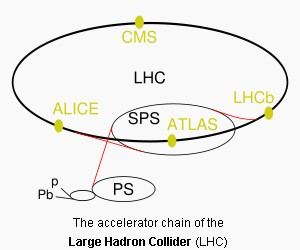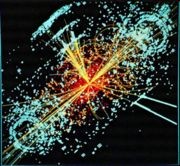The Large Hadron Collider is big, big news at the moment. Described as the biggest, most complicated machine ever built it will hopefully help physicists solve some of the great mysteries of space and time, such as: What happened a trillionth of a second after the Big Bang? Why does matter have mass? Where did all the antimatter go? Are there seven more dimensions wrapped up very, very small indeed? What happens when you make a microscopic black hole travelling at 99.999999% the speed of light in a giant metal ring beneath 100 metres in the Swiss countryside?
Well, here’s a short primer to bring you up to speed on the LHC and the so-called God Particle it hopes to find.
What is the Large Hadron Collider?
It is an internationally funded research installation based at CERN on the Swiss-French border. It is composed of millions of parts, weighing tens of thousands of tonnes in total and situated 100 metres below ground. It is shaped like an enormous, hollow doughnut, a torus shape, with various instruments and controls stationed around the ring at strategic points. Thousands of scientists and engineers have worked on the LHC and thousands will be involved in the research carried out. there.
What’s the operating temperature of the LHC?
It will operate at -271 Celsius, that’s an extremely chilly 1.9 degrees above absolute zero.
 What will the LHC do?
What will the LHC do?
Put simply, the LHC will create beams of particles, known as hadrons, that will travel around the ring at speeds approaching that of the speed of light. Ultimately two beams travelling in opposite directions will be created and allowed to collide. The high-energy collision (7 tera-electronvolts; 0.23×10-7 Joules roughly the equivalent of a head-on collision between two fruit flies but packed into a subatomic volume) will mimic conditions in the universe a trillionth of a second after the Big Bang and hopefully give scientists new insights into matter, energy, space, time, and other dimensions.
What is a hadron?
A hadron (pronounced had-ron, as opposed to hay-dron) is any sub-atomic particle composed of quarks and/or gluons. They include the well-known protons and neutrons found in the atomic nucleus. but also include the more exotic lambda and omega particles, pions and kaons.
What are the various instruments around the ring and what will they measure?
Atlas – A Toroidal LHC ApparatuS (a rather contrived acronym, if ever there was one) is a general purpose detector and will spot all kinds of particles produced by hadron collisions.
CMS – Compact Muon Solenoid – is also a general purpose detector that can measure the energy and momentum of photons (particles of light), electrons (particles of electricity), muons (superheavy electrons).
LHCb – LHC-beauty – a detector aimed at spotting symmetry violations in specific hadron collisions.
ALICE – A Large Ion Collider Experiment – the main particle tracking device.
TOTEM – Total Cross Section, Elastic Scattering and Diffraction Dissociation – does what it says on the tin, measures various energies.
LHCf – LHC-forward – measures any bow wave effects during a hadron collision.
How much has it cost?
2.6 billion pounds (about $4.6 billion) with the Collider itself costing about two-thirds of that and the detectors a third.
What’s the cost to the UK?
Apparently, it works out at about the price of a pint of beer per year for every person in the country.
Isn’t that a waste of money, what about curing HIV and cancer?
Scientists are spending more than that on finding cures for HIV and cancer, this is additional research. Moreover, the results from this study could revolutionise not only physics but the way we see the world and the technologies and medicine we might one day create. Sceptics said something similar about the discovery of the electron in 1897, and look where that discovery has taken us so far.
What does CERN stand for?
Conseil Européen pour la Recherche Nucléaire’ (in English the European Council for Nuclear Research).
So, this is all about weapons?
Not at all, the nuclear refers only to the fact that the research is into the nucleus of the atom.
 Where does the God particle come into all this?
Where does the God particle come into all this?
The so-called God particle, is known as the Higgs boson. This is a hypothetical sub-atomic particle thought to endow matter with its substance, its mass and so is closely related to gravity. The particle was postulated by three physicists, François Englert and Robert Brout, and Peter Higgs who hypothesised its existence in 1964. If its existence is proven by LHC experiments it will validate the Standard Model of modern physics and provide the foundations for deriving a Grand Unified Theory of everything.
When will they start doing actual experiments rather than tests?
The LHC is the most complex machine ever built, millions of components have to work together in perfect harmony before hadron collisions can begin, it will be weeks, if not months, before the scientists carry out the first actual experiments to search for the God Particle.
Will we hear about the results as soon as the first experiments are done?
Once experiments are underway, the LHC will be producing petabytes of data (a petabyte is a billion megabytes), which simply cannot be processed by even today’s supercomputers. CERN is developing an ultrapowerful distributed Grid computing network (like email on steroids) that will process the data and give the thousands of scientists material to work with for years to come. My guess is that the first scientific paper of import from LHC will not be published until at least 2010, although preliminary results will no doubt appear before that.
Does the Big Bang theory hinge on the existence of the Higgs boson?
No, not at all. Higgs and his colleagues simply postulated a framework to explain why particles are made of stuff, i.e. have a mass.
What happens if the LHC does not find the Higgs boson?
A null result for the Higgs will imply that the BEH mechanism of how matter gets its mass is probably wrong, which will in turn imply that the Standard Model of modern physics is also wrong. However, the LHC results will not be wasted as Stephen Hawking and others predict that something even more bizarre will emerge from the collisions that will help scientists construct new theories. Some scientists are even hoping that they won’t find the Higgs as what they will find could be even more exciting.
Will the LHC produce a black hole that will suck the earth into it and kill us all in a primordial vortex of doom?
No.
Really?
Yes. Although the LHC is a huge experiment creating massive energies, these are similar to the millions of collisions that take place between hadrons in the earth’s upper atmosphere as cosmic rays bombard the planet. With long odds of 50-billion to 1 against of a microscopic black hole even forming, the chances of it not simply falling apart on its creation and spawning a shower of new and exotic particles are as close to zero as you can get.
So Torchwood has got it wrong?
Most certainly. Captain Jack John Barrowman may have visited the LHC during its erection but I think he was hoping to experience not a large hadron collision but something typographically different.
Where can I watch the LHC Rap?
Right here.
Will there be an Extra Large Hadron Collider?
Yes. Eventually. Although the LHC is big and high power, it is just one in a long(ish) line of colliders of increasing power. It will only be able to peer back in time to the first trillionth of a second after the Big Bang, inevitably scientists will want to push that limit further by going to higher energies, which means a bigger still collider.
Credits: LHC Schematic drawn by Wikipedia contributor Arpad Horvath. You can read a comment from Sciencebase reader Dr Walter L. Wagner on the subject of black holes and revelations here.